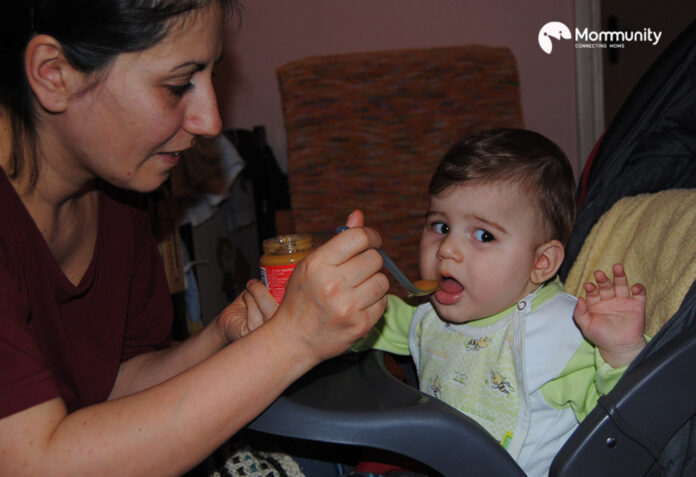Are you a parent who thinks his baby is always hungry? When can babies start eating baby food? Well, introducing food to your infant could be a critical point of reference in their improvement, stamping the start of a new culinary journey.
As a parent, you’ll think about when the right time is to start incorporating baby food into your little one’s diet. Sometimes, it’s a tough job to feed your little one every now and then. This may also make your kid cranky because their tummy is empty.
In this blog, you will learn more about when can babies start eating baby food. Let’s dig into more details.
Understanding Baby’s Developmental Milestones
Before introducing solid foods, it’s fundamental to consider your baby’s formative preparation. Whereas each child creates at their own pace, there are common signs to observe for that show they are prepared to investigate modern tastes and surfaces:
1. Capacity to Sit Up
Your infant ought to be able to sit up with negligible support and demonstrate great head and neck control. This can be vital for secure gulping and assimilation.
2. Misfortune of Tongue-Pushed Reflex
Babies are born with a characteristic reflex that pushes nourishment out of their mouths. Around four to six months of age, this reflex lessens, permitting them to move nourishment to the back of their mouths for gulping.
3. Increased Interest in Food
On the off chance that your child appears intrigued in observing what you eat, comes for food, or opens their mouth when advertised with a spoon, they may be prepared to begin testing with solids.
4. Development of Pincer Grasp
As your baby’s fine engine abilities are created, they may start to choose little objects or food between their thumb and forefingers as a sign of availability for self-feeding.
Timing Is Key
The American Institute of Pediatrics (AAP) suggests presenting solid food around six months of age, solely breastfeeding or formula-feeding until that point. Holding up until six months guarantees that your baby’s stomach-related framework is adequately developed. A baby’s stomach can handle food and diminishes the chances of allergies and other unfavorable responses.
As your baby becomes more accustomed to eating solids, gradually introduce a variety of fruits, vegetables, grains, and proteins, paying attention to any signs of allergic reactions. Give some time for the baby’s stomach to adapt to the food, fruits, and vegetables. It’s a slow process, and you need to be patient.
Choosing Right Food
When it comes to selecting infant food, start with single-ingredient, smooth purees. To bolster your baby’s developing needs, begin with iron-rich food like iron-fortified cereals, pureed meats, or vegetables.
As your infant becomes more accustomed to eating solids, steadily present an assortment of natural products, vegetables, grains, and proteins, paying consideration to any signs of unfavorably susceptible responses.
Sign Of Readiness
As you set out on this travel of presenting solid food to your child, observe for the taking after signs that demonstrate they are prepared for this unused culinary enterprise:
1.Eagerly Opens Mouth
When advertised with a spoonful of food, your infant energetically opens their mouth and inclines forward in expectation.
2. Swallows Effortlessly
Your infant can move food from the front of their mouth to the back and swallow it with negligible trouble or choking.
3. Shows Interest in Food
Your infant comes to for nourishment or appears interested when they see others eating, showing a preparation to investigate unused flavors and surfaces.
4. Tolerates Different Textures
As you present an assortment of surfaces, from smooth purees to delicate solids, your infant illustrates a capacity to endure and appreciate these contrasts.
Baby-Led Weaning vs. Traditional Spoon-Feeding
When it comes to introducing solids, guardians have two fundamental approaches: baby-led weaning and conventional spoon-feeding.
1. Baby-Led Weaning
This strategy includes advertising age-appropriate finger foods that your child can handle and eat themselves. It empowers free eating and permits babies to investigate surfaces and flavors at their own pace.
2. Conventional Spoon-Feeding
In this approach, guardians spoon-feed pureed or squashed nourishments to their babies, steadily presenting diverse surfaces and flavors over time. This strategy gives more control over what and how much your infant eats.
The Final Note
Introducing solid food to your child is an energizing turning point that marks the start of their culinary journey. By watching your baby’s formative preparation and paying attention to signs of intrigue and resistance, you’ll decide the correct time to begin consolidating child nourishment into their count calories.
We hope you find an answer to when can babies start eating baby food through this blog. Keep in mind to select nutrient-rich food, offer an assortment of flavors and surfaces, and permit your infant to investigate at their own pace. With persistence, direction, and bounty of cherish, you’ll be able to sustain your baby’s developing craving and cultivate a long-lasting adore of sound eating.




